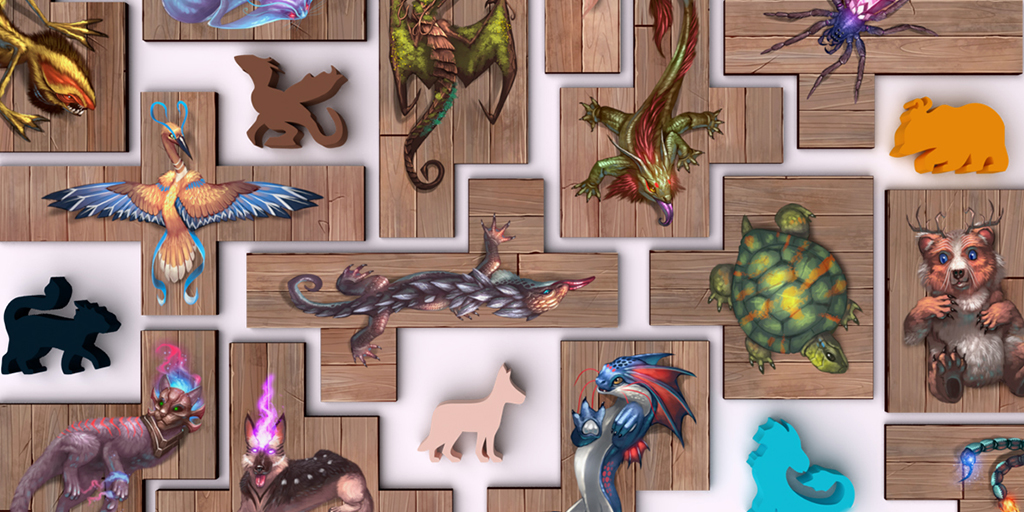Let’s dive into the Beast module!

Today I would like to dive into the Beast module, letting you know how it came to be and how it works.
This is the third designer post I have made, and you can find the other two here:
Introduction
The Beast module is a medium complexity module and sits between the previously discussed kitten module, and the unannounced 3rd module. Please keep in mind, complexity is not evaluated by the rules but by how much it impacts player decisions.
This module works for the family, standard, and solo modes, and for anyone who already has the Late Arrivals expansion, it will work with up to 6-players.
The background
When I started working on the Beast module there were 3 areas of the game that I had on my list for review, and I discovered my issue with all of them boiled down to one simple thing.
1. Lesson cards
One of my favourite parts of The Isle of Cats is the lesson cards, they play a critical part in making the game feel different each time you play and can easily be swapped with different lesson cards to provide a new experience.
Lesson cards are one of the primary ways to score points and often players will look to collect the perfect set of lessons and choose cats based on what they need to complete those cards.
The problem is sometimes you get lesson cards that don’t set too much direction like “get exactly 5 red cats” and it takes a while before you have enough lesson cards to start impacting your placement decisions. Without lesson cards providing positional requirements such as “fill the outside of your boat” or “leave the dining room empty”, in the early game you fall into the same issue you would have if lesson cards did not exist, where you are simply rescuing cats and placing them neatly onto your boat.
There is nothing wrong with this, but without early direction players often end up doing the same thing for the first round of the game, each time they play.
2. New players
It is also interesting to watch new players experience The Isle of Cats as not everyone immediately sees the value in lesson cards. While experienced players may grab as many as they can, new players are typically focussed on more standard polyomino game goals and simply try to fill their boat without doing anything else.
This can leave them without interesting goals to achieve during the game and little direction. The vast majority of players do see the value of lesson cards in their second play but I believe the first experience of any game is always critical to someones long-term enjoyment.
3. The edge
If you sit down and watch people playing The Isle of Cats you will notice a logical trend in the first tile placement. Most players will look for a cat tile that fits neatly around the edge of their boat, perhaps a plus shaped cat to fill the captain’s room, or a z-shape to start filling the storage room.
It makes sense as you want to be efficient and closing off a tricky edge on your first turn is the perfect move if you do not have anything else to aim for.
As the designer, I would love to make you start on the most central square as it is much more challenging to fill outwards than it is to fill across, but currently there is little reason for you to choose to do that.
So, what was the thing?
All these points can be boiled down to early game direction and this is where the Beast module comes in.
I wanted to keep it quick and easy to play, I wanted to keep the ruleset minimal to encourage newer players to engage with it, and I wanted to give players a big enough reward for choosing to start in the middle of their boat so they would have a harder time towards the end of the game.
Perfectly played the Beast module can reward you with up to 60 points but good luck getting more than 20!
How the Beast module works
During the first day, and only the first day, you will fill the right (5 fish) field with beasts instead of cats.
For example:
- In a 2-player game you will have 4 cats in the left field and 4 beasts in the right field.
- In a 4-player game you will have 8 cats in the left field and 8 beasts in the right field.
Beasts are rescued in the exact same way cats are, requiring 1 basket and 5 fish, and they follow all the usual tile placement rules.
To keep them happy you will need to form friendships between the beasts and the cats on your boat.
Forming friendships

Each beast tile contains 3-4 cat icons and to form friendships, a square containing a cat icon must be touching a matching cat.
For example, if there is a red cat icon on a beast tile, then a red cat must be touching the square on the beast tile that contains that red cat icon.
Furthermore, to complete the friendship the touching cat must be part of a family, and for each friendship formed by the end of the game you will score 5 points. Once you have formed a friendship, you will place a beast meeple over the gap between the beast tile and connected cat family to show the friendship is complete.
If you have a beast tile with 4 icons and you manage to connect 3 cat families to their matching icons, you will score 15 out of a possible 20 points.
Keep in mind, Beasts are not cats, they do not have a colour, and there are no lesson cards that refer to beasts directly.
A bit of maths
While the original aim of this module was to improve the early game and give new players a better experience, the experts among you will come to realise beasts can be very rewarding.
As a bit of quick maths for anyone wondering, here are a few things to keep in mind:
1. Playing with 1 beast
If you have 4 cat families and each cat family has 3 cats in it, you will score 32 points, 8 per family.
If one of those families gained 1 extra cat, you would gain an extra 3 points, so 35 in total.
However, if instead that extra cat was a beast, you would gain 20 points bringing your total to 52.
In this situation the beast may cost the same as a cat but is worth 17 extra points.
2. Playing with 3 beasts
It is possible to have up to 3 beasts on your boat, and one cat family can connect to multiple beasts.
If you somehow manage to find a way to create 5 families of 3 cats and connect them to all 12 icons on your 3 beast tiles, you will gain an extra 60 points.
Of course, this is harder to do than filling your boat but maybe you will find a middle ground that will be perfect for your strategy?
Components
The Beast module comes with 18 unique beasts, a red beast bag, and 25 (5 of each type) beast meeples that can be used for marking friendships.
When placing a beast meeple, the colour or shape does not matter, you may choose to use your favourite beast figure to decorate your boat.
Conclusion
This module introduces minimal rules, is very easy to plug and play but adds a lot of new decisions. Beasts are best placed in the middle of your boat, will give you direction from the start of the game, and can both outscore and work in harmony with lesson card strategies when played correctly.
Beasts offer a viable new strategy for winning the game, they encourage mass-family strategies, and now, from the very first tile you place on your boat you will have multiple goals to be working towards.
The Beast module will be available on Kickstarter on May 25th and you can follow along here.
If you have enjoyed this article, please do consider sharing it on your favourite websites and in your favourite board game communities. I am working hard on spreading news of this expansion and would love your help as the majority of people still don’t know it is coming!
Frank West
Frank West is a gamer and designer based in Bristol, UK. He published his first board game, The City of Kings, in 2018 and now works on other games and organising events in the local area. His goal? To design and publish games focusing on immersive themes, fun mechanics and beautiful components. If you have any questions or would just like a chat, feel free to get in touch at any time!

